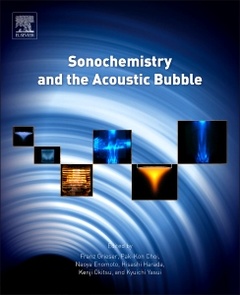Description
Sonochemistry and the Acoustic Bubble
Coordinators: Grieser Franz, Choi Pak-Kon, Enomoto Naoya, Harada Hisashi, Okitsu Kenji, Yasui Kyuichi
Language: English
Subjects for Sonochemistry and the Acoustic Bubble:
Keywords
$OH radicals; Acoustic cavitation; Advanced oxidation processes; Alkali-metal atom emission; Apoptosis; Atomization; Attenuation; Biofuels; Bjerknes force; Bremsstrahlung; Bubble collapse; Bubble pulsation; Calorimetry; Carbon dioxide; Cavitation; Cavitation noise; Cavitation threshold; Cavitational effect; Characteristic impedance; Chlorofluorocarbons; Cleaning; Colloids; Crystal growth; Diagnosis; Dispersions; Emulsification; Emulsions; Extraction; Food processing; Free radical formation; Gene response; Hazardous chemicals; Heterogeneous reactions; HIFU; Historical developments; Homogeneous reactions; Hot spot; Hydroxyl radicals; Impedance; Janus particles; KI method; LIPUS; Liquid height; Liquid jet; Longitudinal wave; Luminol luminescence; Membrane separation; Minnaert equation; Multibubble sonoluminescence; Nanoparticle synthesis; Nanoparticles; Nonlinear propagation; Nucleation; Numerical simulation; Organic synthesis; Particle velocity; Piezo-electric ceramics; Plane wave; Plasma; Pollutant degradation; Polymer latex; Polymerization; Precipitation; Pyrolysis radical; Pyrolysis reactions; Radicals; Rayleigh collapse; Rayleigh-Plesset equation; Reactor; Reflection; Scale up; Scattering; Second harmonic; Shock wave; Single-bubble sonoluminescence; Sonochemical efficiency; Sonochemical engineering processes; Sonochemical reactor; Sonochemical switching; Sonochemiluminscence; Sonochemistry; Sonoluminescence; Sonolysis; Sonophotocatalysis; Sonoporation; Sound intensity; Sound pressure; Standing wave; Surface modifications; Suspensions; Synergic effect; Therapy; Thermal effect; Transducer; Ultrasonic power; Velocity dispersion; Vesicles
298 p. · 19x23.3 cm · Hardback
Description
/li>Contents
/li>Biography
/li>Comment
/li>
Sonochemistry and the Acoustic Bubble provides an introduction to the way ultrasound acts on bubbles in a liquid to cause bubbles to collapse violently, leading to localized 'hot spots' in the liquid with temperatures of 5000° celcius and under pressures of several hundred atmospheres.
These extreme conditions produce events such as the emission of light, sonoluminescence, with a lifetime of less than a nanosecond, and free radicals that can initiate a host of varied chemical reactions (sonochemistry) in the liquid, all at room temperature.
The physics and chemistry behind the phenomena are simply, but comprehensively presented. In addition, potential industrial and medical applications of acoustic cavitation and its chemical effects are described and reviewed.
The book is suitable for graduate students working with ultrasound, and for potential chemists and chemical engineers wanting to understand the basics of how ultrasound acts in a liquid to cause chemical and physical effects.
Chapter 1. Acoustic Field and Bubbles Chapter 2. Dynamics of Acoustic Bubbles Chapter 3. Sonochemistry Chapter 4. Sonoluminescence Chapter 5. Experimental Methods in Sonochemistry Chapter 6. Applications in Chemical Engineering Chapter 7. Applications in Organic Synthesis Chapter 8. Applications in Inorganic Synthesis Chapter 9. Bio and Medical Applications Chapter 10. Applications in Environmental Technologies
Professor Pak-Kon Choi received his Bachelor in.Science from the University of Tokyo in 1974, and his Ph.D. from the University of Tokyo in 1979. He is now a professor of Department of Physics, School of Science and Technology, Meiji University. His research interests are in physical ultrasonics, acoustic-cavitation dynamics and sonoluminescence. Professor Choi has published over 50 articles, including review papers on ultrasonic spectroscopy and acoustic cavitation, in physical chemistry and physics journals.
Professor Naoya Enomoto received his B.E. in 1987 and M.E. in 1989 from Tokyo Institute of Technology. After he worked for the Nihon Cement Co. (currently known as Taiheiyo Cement Coop.) in 1989-1991, he joined the Research Laboratory of Engineering Materials (currently known as the Materials & Structures Laboratory) at Tokyo Institute of Technology as a Research Associate, and received his PhD in 1997. In 2000, he became an Associate Professor at Kyushu University. He has published over 100 peer-reviewed research articles and over 10 patents in the field of ceramic materials engineering, including sonoprocessing.
Professor Hisashi Harada is currently Professor of Chemistry at Meisei University at Tokyo, Japan. He received his B.Sc. in 1973 and Ph.D. in Science in 1987 at Meisei University. He is a Board Member of JSS (Th
- Experimental methods on acoustic cavitation and sonochemistry
- Helps users understand how to readily begin experiments in the field
- Provides an understanding of the physics behind the phenomenon
- Contains examples of (possible) industrial applications in chemical engineering and environmental technologies
- Presents the possibilities for adopting the action of acoustic cavitation with respect to industrial applications




